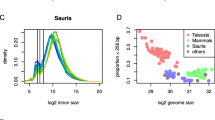Abstract
In this paper we investigate the relationships among intron density (number of introns per kilobase of coding sequence), gene expression level, and strength of splicing signals in two species: Drosophila melanogaster and Caenorhabditis elegans. We report a negative correlation between intron density and gene expression levels, opposite to the effect previously observed in human. An increase in splice site strength has been observed in long introns in D. melanogaster. We show this is also true of C. elegans. We also examine the relationship between intron density and splice site strength. There is an increase in splice site strength as the intron structure becomes less dense. This could suggest that introns are not recognized in isolation but could function in a cooperative manner to ensure proper splicing. This effect remains if we control for the effects of alternative splicing on splice site strength.





Similar content being viewed by others
References
Altschul SF, Madden TL, Schaffer AA, Zhang J, Zhang Z, Miller W, Lipman DJ (1997) Gapped BLAST and PSI-BLAST: a new generation of protein database search programs. Nucleic Acids Res 25:3389–3402
Bennetzen JL, Hall BD (1982) Codon selection in yeast. J Biol Chem 257:3026–3031
Bortoluzzi S, Danieli GA (1999) Towards an in silico analysis of transcription patterns. Trends Genet 15:118–119
Castillo-Davis CI, Mekhedov SL, Hartl DL, Koonin EV, Kondrashov FA (2002) Selection for short introns in highly expressed genes. Nat Genet 31:415–418
Comeron JM (2004) Selective and mutational patterns associated with gene expression in humans: influences on synonymous composition and intron presence. Genetics 167:1293–1304
Duret L, Mouchiroud D (1999) Expression pattern and, surprisingly, gene length shape codon usage in Caenorhabditis, Drosophila, and Arabidopsis. Proc Natl Acad Sci USA 96:4482–4487
Fields C (1990) Information content of Caenorhabditis elegans splice site sequences varies with intron length. Nucleic Acids Res 18:1509–1512
Fox-Walsh KL, Dou Y, Lam BJ, Hung SP, Baldi PF, Hertel KJ (2005) The architecture of pre-mRNAs affects mechanisms of splice-site pairing. Proc Natl Acad Sci USA 102:16176–16181
Gouy M, Gautier C (1982) Codon usage in bacteria: correlation with gene expressivity. Nucleic Acids Res 10:7055–7074
Grantham R, Gautier C, Gouy M, Jacobzone M, Mercier R (1981) Codon catalog usage is a genome strategy modulated for gene expressivity. Nucleic Acids Res 9:r43–r74
Ikemura T (1981a) Correlation between the abundance of Escherichia coli transfer RNAs and the occurrence of the respective codons in its protein genes. J Mol Biol 146:1–21
Ikemura T (1981b) Correlation between the abundance of Escherichia coli transfer RNAs and the occurrence of the respective codons in its protein genes: a proposal for a synonymous codon choice that is optimal for the E. coli translational system. J Mol Biol 151:389–409
Mount SM, Burks C, Hertz G, Stormo GD, White O, Fields C (1992) Splicing signals in Drosophila: intron size, information content, and consensus sequences. Nucleic Acids Res 20:4255–4262
Munoz ET, Bogarad LD, Deem MW (2004) Microarray and EST database estimates of mRNA expression levels differ: the protein length versus expression curve for C. elegans. BMC Genomics 5:30
Rice P, Longden I, Bleasby A (2000) EMBOSS: the European Molecular Biology Open Software Suite. Trends Genet 16:276–277
Rogan PK, Faux BM, Schneider TD (1998) Information analysis of human splice site mutations. Hum Mutat 12:153–171
Sharp PM, Li WH (1987) The Codon Adaptation Index—a measure of directional synonymous codon usage bias, and its potential applications. Nucleic Acids Res 15:1281–1295
Urrutia AO, Hurst LD (2003) The signature of selection mediated by expression on human genes. Genome Res 13:2260–2264
Weir M, Rice M (2004) Ordered partitioning reveals extended splice-site consensus information. Genome Res 14:67–78
Weir M, Eaton M, Rice M (2006) Challenging the spliceosome machine. Genome Biol 7:R3
Zheng CL, Fu XD, Gribskov M (2005) Characteristics and regulatory elements defining constitutive splicing and different modes of alternative splicing in human and mouse. RNA 11:1777–1787
Acknowledgments
We wish to thank Laurent Duret for helpful discussions. This work was funded by Science Foundation Ireland and the Irish Health Research Board.
Author information
Authors and Affiliations
Corresponding author
Additional information
Reviewing Editor: Dr. Nicolas Galtier
Rights and permissions
About this article
Cite this article
Fahey, M.E., Higgins, D.G. Gene Expression, Intron Density, and Splice Site Strength in Drosophila and Caenorhabditis . J Mol Evol 65, 349–357 (2007). https://doi.org/10.1007/s00239-007-9015-y
Received:
Accepted:
Published:
Issue Date:
DOI: https://doi.org/10.1007/s00239-007-9015-y




